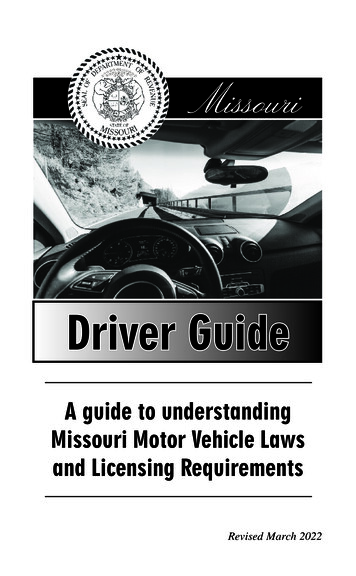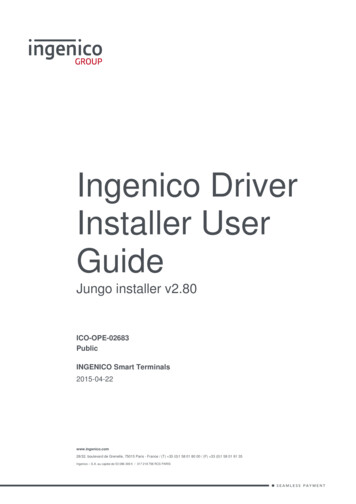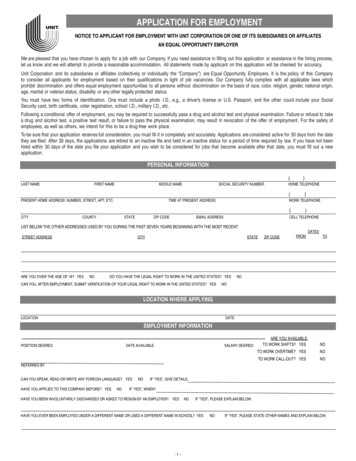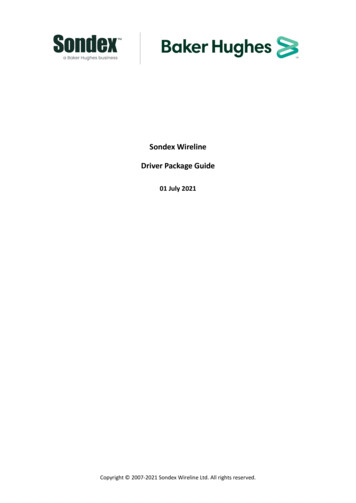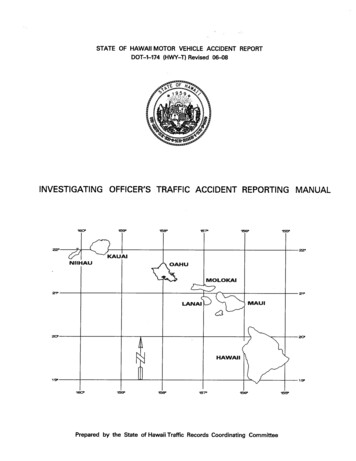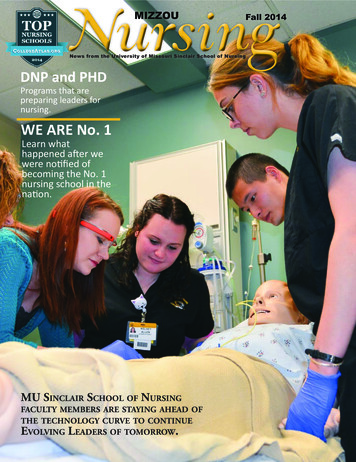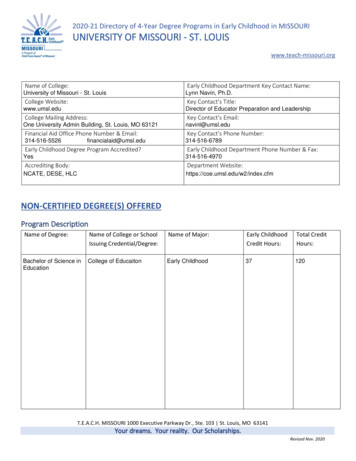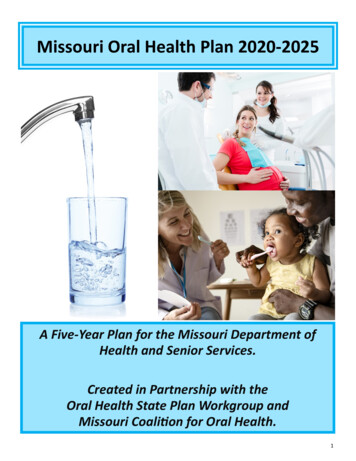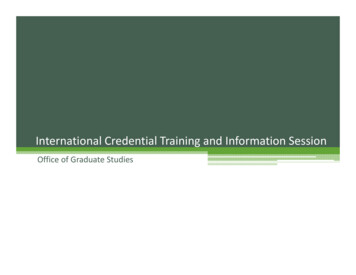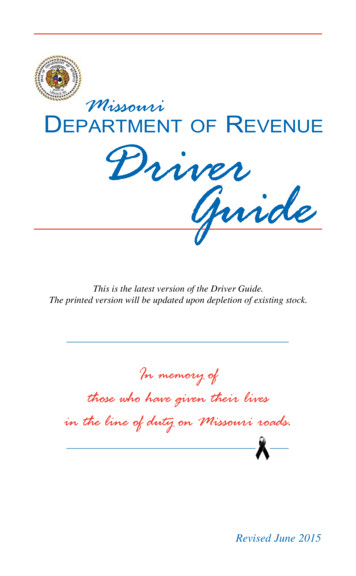
Transcription
MissouriDepartmentofRevenueDriverGuideThis is the latest version of the Driver Guide.The printed version will be updated upon depletion of existing stock.In memory ofthose who have given their livesin the line of duty on Missouri roads.Revised June 2015
Table of ContentsChapter 1 — The Missouri Driver License and the GraduatedDriver License Law.Page 7 Types of Permits. 7 Types of Licenses. 8 Requirements to Obtain Your License or Permit. 9 Required Documents. 10 Social Security Number. 11 Fees for Permits/Licenses. 12 Restrictions. 13 Endorsements. 13 Renewing a License or Permit. 14 Other Information About Your Driver License. 15 Suspension/Revocation of Your License. 18 The Graduated Driver License (GDL) Law. 19 Step One: Instruction Permit . 19 Step Two: Intermediate License. 19 Step Three: Full (Under 21) License. 20 A Checklist for You. 21Chapter 2 — The Driver Exam.Page 22 Where to Take the Exam. 22 Verification of Name and Age. 22 Written Test. 22 Vision Test. 22 Road Sign Test. 23 Driving Test. 23 Your Grade. 25 Failing the Driving Test. 25 Fraud. 25Chapter 3 — Pavement Markings, Traffic Signs,Lights, and Signals.Page 26 Pavement Markings on the Road. 26 Meanings of Pavement Markings. 26 Direction of Traffic. 26 No Passing Zones. 26 Left-Turn Lanes. 27 Crosswalks and Stop Lines. 27 Dual Use Lanes. 27 Reversible Express Lanes. 28 Shared Center Lanes. 28 No Lane Markings. 28 Traffic Officers. 28 Traffic Signals. 28 Flashing Light Signal. 29 Traffic Control Signals. 29 Lane Use Control Signals. 301
Traffic Signs. 30Sign Shapes. 31Warning Signs. 31Regulatory Signs. 35Stop Sign. 36Yield Sign. 37Wrong Way Sign. 37Do Not Enter Sign. 37Lane Control Signs. 37Speed Limit Signs. 37Railroad Crossing Sign. 38Work Zone Signs. 39Guide Signs. 40Service Signs. 40Route Signs. 40Emergency Reference Markers. 40Chapter 4 — Rules of the Road. Page 41 Right-Of-Way. 41 Passing. 41 Intersections. 42 Emergency Vehicles. 42 School Buses. 42 Hand and Vehicle Signals. 43 Turns. 43 U-Turns. 44 Right Turns. 44 Left Turns. 44 One-Way Street Onto a Two-Way Street. 44 Two-Way Street Onto a One-Way Street. 44 Two-Way Street Onto a Two-Way Street. 45 Multiple Left Turn Lanes. 45 Two-Way Left Turn Lanes. 45 Roundabout Intersections. 46 J-Turn Intersections. 47 Local Ordinances. 47Chapter 5 — Parking. Page 48 No-Parking Zones. 48 When Can You Park in Handicapped Parking Spaces?. 48 International Symbol of Access. 49 Parking on Hills. 49 Parallel Parking. 50Chapter 6 — Highway Driving. Page 51 Drive in the Proper Lane. 51 Controlling Speed. 51 Passing on Highways. 51 Being Passed. 52 Adjusting to Traffic. 522
Be Aware of the Traffic Around You. 52Slow Moving Traffic. 52Stopping. 53Controlled Access Highways. 53Entering the Highway. 53Leaving the Highway. 54Interchanges. 55Watch out for “Highway Hypnosis”. 55Stop Driving When You Feel Sleepy. 55Emergencies. 55Chapter 7 — Sharing The Road. Page 56 Sharing the Road with Motorcycles. 56 Sharing the Road with Large Trucks. 57 Sharing the Road with Pedestrians. 58 Sharing the Road with Mopeds and Bicycles. 59 Funeral Processions. 62 Road Rage. 62 Drunk Drivers. 63 About Littering. 63Chapter 8 — Safe Driving Tips For Everyday Driving. Page 64 Use Seat Belts and Child Restraints. 64 Seat Belts — It’s the Law. 64 Child Passenger Restraint Law. 64 Age/Weight/Height Classifications. 64 Defensive Driving. 65 Proper Posture While Driving. 65 Steering. 65 Following Other Vehicles. 66 Three Second Rule. 66 Space Behind. 66 Space to the Side. 66 Stopping Distance. 67 Average Stopping Distance of Cars on Dry Level Pavement. 67 Letting Others Know What You are Doing. 68 Signal When You Change Direction. 68 Using Your Horn. 68 Slow Poke Driving. 68 Carbon Monoxide. 68 Tips for Avoiding a Deer-Vehicle Crash. 69 What is Distracted Driving. 70Chapter 9 — Safe Driving Tips For SpecialDriving Conditions. Page 72 Night Driving. 72 Winter Driving. 72 Wet Pavement. 73 Hydroplaning. 73 Anti-Lock Brakes (ABS). 743
Skidding. 74Fog. 74Handling Vehicle Emergencies. 74Brake Failure. 75Tire Blowout. 75Running Off Pavement. 75Steering Failure. 75Headlight Failure. 75Stuck Accelerator. 75Blocked Vision. 76Vehicle Approaching Head-on in Your Lane. 76Stalling on Railroad Tracks. 7612 and 15 Passenger Van Safety. 76Chapter 10 — Be in Shape to Drive.Page 77 Alcohol, Drugs, and Driving Administrative Actions. 77 Court Convicted Actions. 78 Missouri’s Abuse and Lose Law. 80 Minor in Possession (MIP) and Other Alcohol Offenses. 80 Proof of Insurance. 80 Refusal to Submit to a Chemical Test. 81 Ignition Interlock and Reinstatement Requirements. 81Chapter 11 — The Point System and How It Affects You. Page 82 Racking Up Points: The Consequences. 82 How Points Come Off Your Driving Record. 83 Other Consequences. 83 Driving While Suspended or Revoked. 83 Failure to Appear in Court (FACT). 83Chapter 12 — Vehicle Titling and Registration.Page 84 Titling Your Vehicle. 84 What You Need to Get a Title. 84 Vehicles Bought in Missouri. 84 Vehicles Bought Out-of-State (not in Missouri). 84 Properly Assigned Titles. 85 Salvage Vehicles. 85 Odometer Readings. 85 Registering Your Vehicle. 85 What You Need to Register Your Vehicle. 86 Other Information. 87 Selling a Vehicle. 87 Stolen License Plates and Tabs. 87 Lost or Destroyed Title, Plates, or Tabs. 87 Personalized and Specialty License Plates. 87Chapter 13 — Mandatory Insurance.Page 88 The Basics. 88 Minimum Coverage Requirements. 884
Maintaining Your Insurance. 88 Failure to Keep Insurance. 89 Failure to Pay for Damages. 89 Traffic Crashes. 90 Filing an Accident Report. 91Chapter 14 — Safety and Emissions Inspectionsand Required Equipment. Page 92 Safety Inspections. 92 Exceptions to the Requirement. 92 Equipment Needed. 93 Other Equipment Required by Law. 94 Emissions Inspections. 95 Exceptions to the Requirement. 95Chapter 15 — Commercial Vehicles.Page 96 Size Limitations (Without Special Permit). 96 Height.96 Width.96 Length.96 Exemptions From Size Limits. 97 Weight Limitations (Without Special Permit). 97 Maximum Weight on Any Single Axle .Pounds. 97 Maximum Weight on Any Tandem Axle. .Pounds. 97 Maximum Gross Weight .Pounds. 97 Overdimension and Overweight Permits. 97 Vehicle Route Map. 98 Federal Motor Carrier Safety Regulations. 98 Transporting Hazardous Material. 98 Emergency Equipment and Signals. 98 Information on Commercial Motor Vehicles. 99 Following Distance. 99 Railroad Crossing. 99 Load Security. 99 Off-Tracking.99 Weigh Stations.100 Tailgaters.100 Space Overhead. 100 Soft Surfaces. 100 Space to Cross or Enter Traffic. 100Sample Test Questions. Page 101Index. Page 108Glossary. Page 111Contact Information. Page 1135
NOTE: The state motor vehicle laws described in this manual are notreproduced in their entirety and the wording is not identical. Due topossible federal and state law changes and Department of Revenue(department) policy, the information in this manual may not always becurrent. The department will make every effort to incorporate any changesas soon as possible. Please visit our website for the most current version.The Missouri Driver Guide is published by the Missouri Department of Revenue.Carefully studying the Missouri Driver Guide will increase your drivingconfidence and broaden your knowledge of Missouri traffic laws. Themore knowledge you have, the safer you are!To test your knowledge of traffic laws, you will need to take a written testof 25 multiple-choice questions. Studying this guide will prepare you forthat test. You must correctly answer 20 questions to pass the test. All ofthe test questions come directly from information found in this guide. Thereare no “trick” questions.To test your ability to drive a vehicle, you must take a driving skills test.Your examiner realizes a driving test will probably be an unusual experiencefor you, and you might even become nervous or uneasy. If you do becomenervous or fearful, please remember your examiner has accompanied manyother people exactly like you, and the examiner rides with you only to makesure you can control your vehicle and observe the rules of safety. Yourexaminer will not try to trick you in any way. Remember that thousands ofpeople pass this test every year and become licensed drivers. If they can doit, so can you! Just relax and do the best you can.We would like to hear your comments and questions about the materialincluded in this manual:Address:Driver License BureauP.O. Box 200Jefferson City, MO 65105-0200Telephone:(573) 526-2407Fax:(573) 522-8174E-Mail:dlbmail@dor.mo.govWeb Site:www.dor.mo.govThe names and telephone numbers of other related agencies and officesare located inside the back cover of this guide.If you need a Missouri Commercial Driver License Manual or MotorcycleOperator Manual, you may request one from the Missouri State HighwayPatrol, or any Motor Vehicle and Driver Licensing Contract Office (contractoffice). The Missouri Commercial Driver License Manual and theMotorcycle Operator Manual are also posted on our website:www.dor.mo.gov.6
CHAPTER 1 — THE MISSOURI DRIVER LICENSEAnyone who operates a motor vehicle or motor-driven cycle on publicroadways in Missouri is required to have a valid driver license. You mayobtain a Missouri driver license at any one of Missouri’s 178 license offices.You must have a Missouri driver license if: You live in Missouri, are 16 years of age or older, and plan to drive. You are a new resident of Missouri and want to drive, even if you have adriver license from another state. You are an out-of-state commercial driver who has moved to Missouriwithin the last 30 days. (Please refer to the Missouri Commercial DriverLicense Manual.)Certain persons are not required to obtain a Missouri driver license. You donot need a Missouri driver license if: You are a member of the armed forces and you have a valid driverlicense from your home state. You are a full-time student and you have a valid driver license from yourhome state. You operate or temporarily operate/move any farm tractor or implementon a highway for agri-related purposes.You are required to carry your driver license or permit when you drive. Ifany law enforcement officer asks to see your driver license or permit, youmust present it. It is against the law for you to allow anyone else to useyour license or permit.TIP! Anyone obtaining a new license or permit is required to show verificationof name, date of birth, place of birth, social security number, and Missouriresidential address. These requirements are explained in detail later in thischapter.TYPES OF PERMITSIf you are under 21 years of age, you will be issued a permit identifying youas a minor.Instruction Permit — Eligible Age: 15This is the first step in Missouri’s Graduated Driver License Program foryoung drivers. Generally, this permit allows a young person to learn to drivewith the supervision of a licensed adult. See later in this chapter for detailedinformation.Motorcycle Instruction Permit — Eligible Age: 15½ or 16You may apply for a motorcycle instruction permit to learn to operate amotorcycle or motortricycle. The age you are eligible to apply may be 15½or 16 years, as described below. 15½ years of age (15 years and 182 days)The Motorcycle Instruction Permit will only be issued if you havesuccessfully completed an approved motorcycle rider training course.You must pass the Class F and Class M written, vision, and road sign7
tests. You must also have the written consent of your parent or legalguardian. This permit allows daylight driving only, within a 50-mile radiusof home, a motorcycle of no larger than 250 cc, and no passengers. 16 years of age or olderIf you are 16 years old or older you may apply for a motorcycleinstruction permit, but the motorcycle rider training course is not required.If you do not have a valid driver license, you must take the Class F andClass M written tests to receive a motorcycle instruction permit.When you are ready, you may take the motorcycle driving test and pay theappropriate fee to become motorcycle qualified.For more information on Missouri’s laws on motorcycles, please obtain acopy of the Motorcycle Operator Manual at the Missouri Highway Patroltesting station or at one of our license offices.TYPES OF LICENSESIf you are under 21 years of age, you will be issued a license identifying youas a minor. When you reach age 21, you may apply and pay for anotherdriver license (without the minor indication) or wait until your under-21license expires.Intermediate License (Class F) — Eligible Age: 16This is the second step in Missouri’s Graduated Driver License programfor young drivers. Generally, this license allows a young person certainrestricted driving privileges. See later in this chapter for detailed information.Full Driver License (Class F) — Eligible Age: 18This is the basic driver license, also called an operator license. You musthave a Class F license to operate any motor vehicle (other than one requiringyou to have a Class A, B, C, or E license.) The Class F license does notallow you to drive a motorcycle unless the license shows the Motorcycle (M)endorsement. Endorsements will be discussed later in this chapter. Youmust pass the Class F written, vision, road sign, and driving tests.For-Hire License (Class E) — Eligible Age: 18When you test for a Class E license, the written exam will include questionsbased on the complete driver guide, but mainly Chapter 15 (CommercialDriver Licenses). You must also pass the vision and road sign tests. If youalready have a Class F license, a driving test is not required. However, youmust still meet the “under 21 requirements” (see page 21) for a full license ifyou apply for a Class E license at age 18. There are a number of reasonsyou may wish to obtain a Class E license, such as: If you receive pay for driving a motor vehicle transporting 14 or fewerpassengers (such as a driver f
roadways in Missouri is required to have a valid driver license. You may obtain a Missouri driver license at any one of Missouri's 178 license offices. You must have a Missouri driver license if: You live in Missouri, are 16 years of age or older, and plan to drive. You are a new resident of Missouri and want to drive, even if you have a
